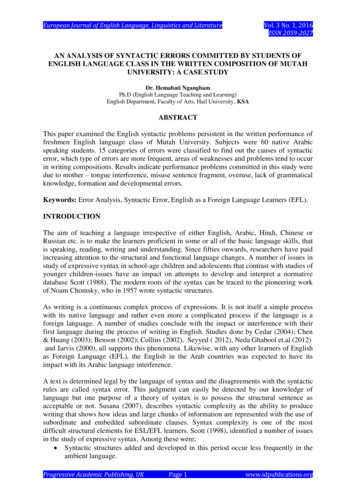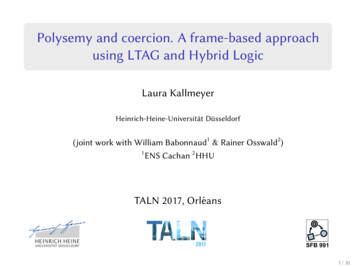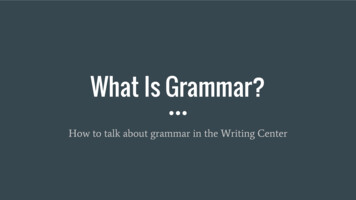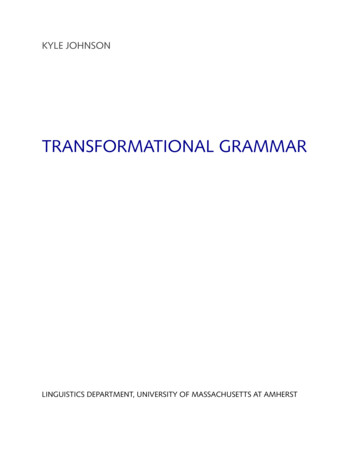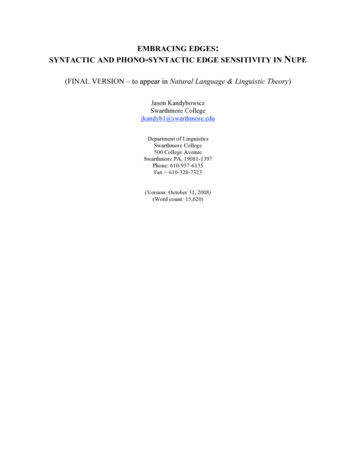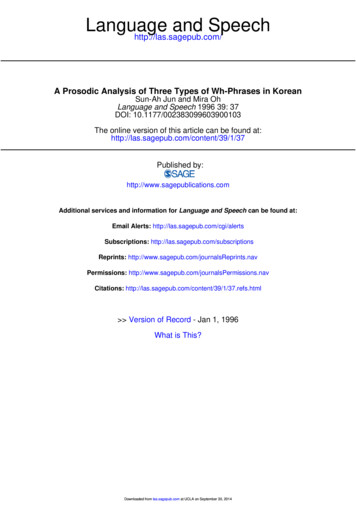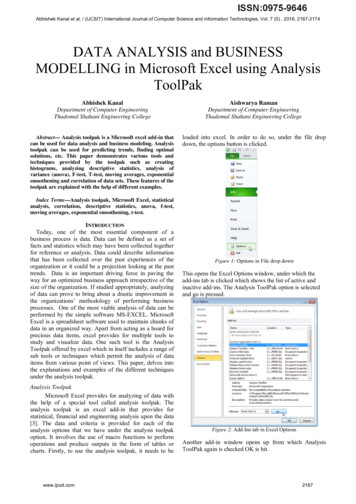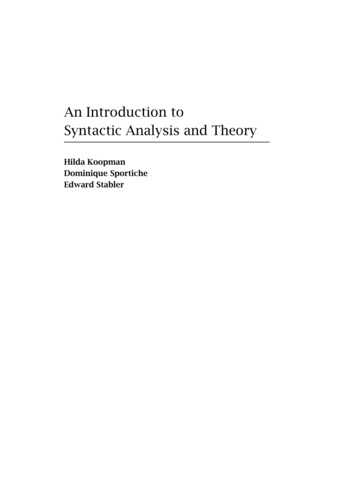
Transcription
An Introduction toSyntactic Analysis and TheoryHilda KoopmanDominique SporticheEdward Stabler
1 Morphology: Starting with words12 Syntactic analysis introduced373 Clauses874 Many other phrases: first glance1015 X-bar theory and a first glimpse of discontinuities1216 The model of syntax1417 Binding and the hierarchical nature of phrase structure1638 Apparent violations of Locality of Selection1879 Raising and Control20310 Summary and review223iii
1Morphology: Starting withwordsOur informal characterization defined syntax as the set of rules or principles that govern how words are put together to form phrases, well formedsequences of words. Almost all of the words in it have some common sensemeaning independent of the study of language. We more or less understandwhat a rule or principle is. A rule or principle describes a regularity in whathappens. (For example: “if the temperature drops suddenly, water vaporwill condense”). This notion of rule that we will be interested in should bedistinguished from the notion of a rule that is an instruction or a statementabout what should happen, such as “If the light is green, do not cross thestreet.” As linguists, our primary interest is not in how anyone says youshould talk. Rather, we are interested in how people really talk.In common usage, “word” refers to some kind of linguistic unit. We havea rough, common sense idea of what a word is, but it is surprisingly difficultto characterize this precisely. It is not even clear that the notion is one thatallows a precise definition. It could be like the notion of a “French language.”There is a central idea to this vague notion but as we try to define it, we areled to making arbitrary decisions as to whether something is part of Frenchor not. Furthermore, as we will see, we may not need any precise versionof this notion at all. Nevertheless, these commonsense notions provide areasonable starting point for our subject. So we will begin with the usualideas about words, objects of the kind that are represented by the strings ofletters on this page separated by blank spaces. When we become literate ina language, we learn the conventions about what is called a word, and aboutspacing these elements in texts. Who decides these conventions, and howdo we learn them? We will gradually get to some surprising perspectives onthis question.1
1. MORPHOLOGY: STARTING WITH WORDS2As we will see, some reasons have been put forth to the effect that wordsare not the basic units of phrases, not the atomic units of syntax. Accordingly, the atoms, or “building blocks” that syntax manipulates would besmaller units, units that we will see later in this chapter. We will also seethat that there are reasons to think that the way these units are combinedis very regular, obeying laws very similar to those that combine larger unitsof linguistic structure.We begin by looking at properties of words informally characterized andsee where it leads. As mentioned above, the subdomain of linguistics dealing with word properties, particularly word structure, is called morphology.Here we will concentrate on just a few kinds of morphological propertiesthat will turn out to be relevant for syntax. We will briefly introduce thesebasic ideas:1 Words come in categories1 Words can be made of smaller units (morphemes)1 Morphemes combine in a regular, rule-governed fashion.a. To define the regularities we need the notions of head and selectionb. The regularities exhibit a certain kind of locality1 Morphemes can be silent1.1 Words come in categoriesThe first important observation about words is that they come in different kinds. This is usually stated as the fact that words come in categories,where categories are nouns, verbs, adjectives, prepositions, adverbs, determiners, complementizers, and other things. Some of these are familiarfrom traditional grammar (e.g. nouns, verbs), others probably less so (complementizers, or determiners).Open class categories: (new words can be freely created in these categories)Noun (N)Verb (V)Adjective (A)Adverb (Adv)table, computer, event, joy, actionrun, arrive, laugh, know, love, think, say, spraybig, yellow, stable, intelligent, legal, fakebadly, curiously, possibly, oftenClosed categories:Preposition (P)Determiner (D)Numerals (Num)Complementizers (C)Auxiliaries (V)Modals (v or M)Coordinators (Coord)Negation/Affirmation (Neg/Aff)on, of, by, through, into, from, for, tothe, a, this, some, everyone, two, three, ten, thirteenthat, if, whether, forhave, bewill, would, can, could, may, might, shall, shouldand, or, butno ,too
1.1. WORDS COME IN CATEGORIES3Each of these categories will need to be refined. For example, there aremany different “subcategories” of verbs some of which are distinguished inthe dictionary: transitive, intransitive, and so on. Most dictionaries do notspecify refinements of the other categories, but they are needed there too.For example, there are many different kinds of adverbs:manner adverbsdegree adverbsfrequency adverbsmodal adverbsslowly, carefully, quicklytoo, enoughoften, rarely, alwayspossibly, probably(Notice also that the degree adverb too in This is too spicy is not the sameword as the affirmative too in That is too, which was mentioned earlier.Similarly, the complementizer for in For you to eat it would be a mistake isoften distinguished from the preposition for in He cooked it for me.)There are even important distinctions among the determiners:articlesdemonstrativesquantifiersa, thethat, this, these, thosesome, every, each, noIn fact, there are important subcategories in all of the categories mentionedabove.This classification of words into categories raises the fundamental questions: What are these categories, that is, what is the fundamental basis forthe distinctions between categories? How do we know that a particular word belongs to a particular category?Traditionally, the categories mentioned above are identified by semanticcriteria, that is, by criteria having to do with what the words mean. A nounis sometimes said to be the name of a person, a thing or a place; a verb is saidto be the name of an action; an adjective the name of a quality; etc. There issome (probably very complicated) truth underlying these criteria, and theycan be useful. However, a simple minded application of these criteria is notalways reliable or possible. Sometimes words have no discernible meaning(the complementizer that), nouns can name actions (e.g. Bill’s the repeatedbetrayal of his friends), verbs and adjectives can denote states (John fearsstorms John is fearful of storms), etc.It is important to keep meaning in mind as a guide but in many caseswe will need more more reliable criteria. The most fundamental idea wewill use is this one: a category is a set of expressions that all “behave thesame way” in the language. And the fundamental evidence for claims abouthow a word behaves is the distribution of words in the language: where canthey appear, and where would they produce nonsense, or some other kindof deviance.
41. MORPHOLOGY: STARTING WITH WORDS1.1.1 Word affixes are often category and sub-category specificIn morphology, the simplest meaningful units, the “semantic atoms,” areoften called morphemes. Meaning in this characterization can be taken either to be "paraphrasable by an idea" (such as the plural morpheme -s whichstand for the idea of plurality, i.e. more than one); but it can also be "indicating a grammatical property" such as an accusative Case ending in Latin orJapanese (such as Japanese -o) which marks a direct object. We will mostlyconcentrate on the former sort here. Then a distinction is often drawn between morphemes which can occur independently, free morphemes, andthose that can only appear attached to or inside of another element, boundmorphemes or affixes. Affixes that are attached at the end of a word arecalled suffixes; at the beginning of the word, prefixes, inside the word, infixes; at the beginning and end circumfixes.Words can have more than one morpheme in them. For example, Englishcan express the idea that we are talking about a plurality of objects by addingthe sound [s] or [z] or [iz] at the end of certain -sNouns can do this (as well as small number of other items: demonstratives,pronouns): in English, the ability to be pluralized comes close to being adistinctive property of Nouns. If a word can be pluralized (and is not ademonstrative or a pronoun), it is a noun.Notice that the characterization of this suffix is partly semantic. So forexample, we know that the [s] sound at the end of reads in the followingsentence is not the plural affix, but some kind of agreement marker in thefollowing sentence:She read-s the newspaperThis fits with the idea that -s is a semantic atom, a meaningful unit that hasno other meaningful units as parts.We can see that there is no plural version of any verb, or of any preposition, or of any adjective. If a word can be pluralized (and is not a demonstrative or a pronoun), then it is a noun. The reverse does not always hold. Thatis, there are some nouns which cannot be pluralized, such as the so-calledmass nouns like furniture or milk. For these mass nouns, some other diagnostic property must be found to decide whether or not they are nouns. Wewill also need some diagnostic that lets us conclude that mass nouns andcount nouns are indeed nouns, do indeed belong to the same superclass.As for the pluralizing test, it only serves to identify a subclass of nouns,namely the count nouns.
1.1. WORDS COME IN CATEGORIES5Other affixes pick out other kinds of categories. English can modify theway in which a verb describes the timing of an action by adding affixes:I danceI danc-edI am danc-ingpresent tense (meaning habitually, or at least sometimes)past tensepresent am progressive -ing (meaning I’m dancing now)In English, only verbs can have the past tense or progressive affixes. That is,if a word has a past or progressive affix, it is a verb. Again, it is importantto notice that there are some other -ing affixes, such as the one that lets averb phrase become a subject or object of a sentence:?He is liking anchovies a lotClearly, in this last example, the -ing does not express that the liking ofanchovies is going on now, as we speak. Going back to the progressive ing, note that although even the most irregular verbs of English have -ingforms (being, having, doing), some verbs sound very odd in progressiveconstructions:?He is liking you a lot *She is knowing the answerShould we conclude that like or know are not verbs? No. This situationis similar to the situation we encountered earlier when we saw that somenouns did not pluralize. This kind of situation holds quite frequently. Remember the slogan:Negative results are usually uninformative.The reason is that we do not know where the failure comes from; it couldbe due to factors having nothing to do with what we are investigating. (Forexample, Newton’s gravitation law would not be disconfirmed by a droppedobject not falling vertically: a priori, there may be wind, or a magnetic fieldif the object is ferromagnetic, etc.). For the same reason, it is difficult forexperimental methodology to simply predict: no change. If you find nochange, this could be because nothing changed, or it could be because yourexperimental methods do not suffice to detect the change.1.1.2 Syntactic contexts are sensitive to the same categoriesSurprisingly, the categorization of words that is relevant for affixation is alsorelevant for simply determining where the word can appear, even withoutaffixes – a “syntactic” property. Consequently, we can use considerationsabout where a word appears to help determine its category. This methodis very useful but is not always easy to manipulate. For example, considerthis context, this “frame”:This is my mostbook
1. MORPHOLOGY: STARTING WITH WORDS6Suppose we try to plug in single words in theslot. Certain choicesof words will yield well formed English phrases, others will not.ok:*interesting, valuable, linguisticJohn, slept, carefully, forThis frame only allows adjectives (A) in the space, but not all adjectives canappear there. For example, we cannot put alleged or fake there. (Remember:negative is uninformative.)One property that (some) nouns have is that they can appear in a slotfollowing a determiner such as the:ok:*theis herebook, milk ,furniturebig, grow, veryAs another example the following context seems to only allow single wordsonly if they are verbs:When will John?Here is an example of a context in which we could be misled:John isok: nice*nicesok: president ok: presidentsBoth nice and president can occur, but president unlike nice can be pluralized. So nice is an A, while president is an N. We must be careful: this contextallows both adjectives and nouns (and other things too)!The possibility of occurring in a frame like the ones listed here is a verysimple distributional property, and it can help us classify words into categories that will be relevant to syntax and morphology. In morphology, wewill see that affixes are sensitive to category, compounding is also sensitiveto category. Why should the possibility of having a certain affix correlatewith the possibility of occurring in a certain frame? We will get some insightinto fundamental questions like this in the next chapters.1.1.3 ModifiersThe options for modification provide another way to identify the categoriesthat are relevant for both word formation (morphology) and phrase formation (syntax). Here we use a mix of semantic and syntactic factors tofigure out what modifies what, in a familiar way. For example, a word thatmodifies a verb is probably an adverb of some kind, and similarly for othercategories:
1.1. WORDS COME IN ensifierDegreeDegree7example[V stop] stop suddenly (a way of stopping)[N stop] sudden stop (a type of stop)[P in] the middle right in the middle, smack in the middle[A sad] very sad, too sad, more sad[Adv sadly] very sadly, too sadly, more sadlyFor example, we can observe that the following sentence allows a modifierto be introduced:John was shooting John was shooting accuratelyAssume we have independently established that accurately is an adverb;since shooting accurately is a way of shooting, we can conclude that in thissentence, shooting is a verb (V). Similarly, in:I resent any unnecessary shooting of lionswe conclude from the fact that unnecessary is an adjective, and from thefact that an unnecessary shooting is a type of shooting that in this sentence,shooting is a noun (N). The reverse may hold true:John shot John shot accuratelySince shot is the past tense of shoot, we know that shot is a verb in thissentence. Since accurately modifies it, we may conclude that accurately isan adverb.1.1.4 Complementary distributionAnother perhaps more surprising kind of evidence for two words havingthe same category is available when the two words have complementarydistribution, by which we mean that in a given context, either one of twoelements may occur but not both. This is a good indication (but certainlynot foolproof) that these two items are of the same category.For example, in the frame:booksonly certain words can occur:okok**thethesethe thesethese theWe see that the and these are in complementary distribution: if one appears,the other cannot. This is evidence that they are both the same category, andin this case it is the category we call determiners (Ds). On the other hand,we have
1. MORPHOLOGY: STARTING WITH WORDS8ok:ok:ok:the bookblue booksthe blue booksSo we see that the and blue are not in complementary distribution, andnothing much follows from this.Like our other tests for category, this one is not fool proof. Consider forexample, this data:ok:**John’s bookthe John’s bookJohn’s the bookWe see that the and John’s are in complementary distribution, but later wewill provide reasons to reject the view that they are the same category –something slightly more complicated explains the complementary distribution in this case. Note however that meaning can be a guide here: John’sexpresses a kind of meaning that seems quite unlike the meaning expressedby the or these.Do categories really exist and if yes what are they? In what follows,we will continue using categorial labels, both traditional ones such as N, V,etc. and less traditional ones such as C, D, etc. We should however beaware that this shorthand may just be a convenient approximation of thetruth but may not be scientifically justified. For everything we will discuss,this approximation will suffice. What kind of issues arise? First, there isthe question of whether categories are primitives of linguistic analysis orare derived concepts. If the latter, they can be entirely defined on the basis of other properties and in a sense, they have no real theoretical status:they are just convenient shorthand. If the former - the traditional, but bythe no means obviously correct, view - they cannot be defined. The problem that arises then is to explain how speakers infer category membershipfor words on the basis of their observed behavior. Secondly there is therelated question of whether the labels that we use meaningfully characterize analytically relevant subset of words. It is quite possible (in fact likely),that the inventory of categories we have is far too crude. Thus, it may bethat categories are like chemical compounds: they are made up of smallerpieces (like molecules or atoms in chemistry, which combine to form morecomplex structures). Under such a view Ns could be like a class of chemicals (say metals) but with many subclasses (e.g. ferromagnetic metals) andcases in which an item could both have metal and nonmetal properties (an"intermediate" category)e.g. conductive plastic polymers.
1.1. WORDS COME IN CATEGORIES9Note on linguistics as cognitive science. In making our judgmentsabout phrases, labeling them “ok” or “*” as we have done above, we areconducting quick, informal psychological experiments on ourselves. To decide what to conclude (e.g., are these two words of the same category?), weare constantly asking ourselves whether this string or that string is acceptable. These are simple psychological experiments. We are relying on thefact that people are pretty good at judging which sequences of words makesense to them and to other people with similar linguistic background, andwe rely on this ability in our initial development of the subject.Obviously, physics is not like this. Useful experiments about electromagnetic radiation or gravitational forces typically require careful measurements and statistical analysis. Many linguistic questions are like physics inthis respect too. For example, questions about how quickly words can berecognized, questions about word frequencies, questions about our abilityto understand language in the presence of noise – these are things that typical speakers of a language will not have interesting and accurate judgmentsabout. But questions about the acceptability of a phrase are different: wecan make good judgments about this. Of course, we require our linguistic theory to make sense of our linguistic judgments and ordinary fluentspeech in “natural” settings and the results of careful quantitative study.In this text, we will occasionally make note of ways in which our accountof syntax has been related to aspects of human abilities which have beenstudied in other ways.In this sense, linguistics is an experimental science trying to uncoversomething about knowledge of language somehow stored in our mind. Whenwe start with our judgments about language, though, there are at least threerespects in which we must be especially careful. First, we want a theory ofour judgments about the language and every speaker of the language hasaccess to an enormous range of data. It is unreasonable to expect linguistictheory to explain all this data at the outset. As in other sciences, we muststart with a theory that gets some of the facts right, and then proceed to refine the theory. This is particularly important in introductory classes: therewill be (apparent) counterexamples to many of our first proposals! We willcarefully set aside some of these, to come back to them later. A second thingthat requires some care is that sometimes our judgments about the acceptability of particular examples are not clear. When this happens, we shouldlook for clearer examples to support our proposals. A third problem facingour development of the theory is that there are at least slight differencesin the linguistic knowledge of any two speakers. Ultimately, our linguistictheory should account for all the variation that is found, but initially, we willfocus on central properties of widely spoken languages. For this reason, wewill often speak as if there is one language called “English,” one languagecalled “French,” and so on, even though we recognize that each individual’slanguage is different.
1. MORPHOLOGY: STARTING WITH WORDS101.2 Words are made of smaller units: morphemesWe defined a morpheme as a semantic atom: it has no meaningful subparts.For our purposes here, this will be a good enough approximation (but weshould be aware that there are many questions lurking in the background,e.g. there exist some morphemes which do not seem to have a meaningattached to them). A word will be called complex if it contains more thanone of these atoms. The part of a word that an affix attaches to is calleda stem, and the root of the word is what you start with, before any affixeshave been added.English morphology is not very rich compared to most of the world’slanguages, but it has prefixes:pre-test, post-test, ex-husband, dis-appear, un-qualified, re-think,in-accurateIt has suffixes:test-s, test-ed, test-able, nation-al-iz-ationIt seems to have a few infixes:Fan-fucking-tasticEdu-ma-cationMeans ’really fantastic’Ghetto speak for ’education‘Many other languages (apparently) also have infixes. For example, in Tagalog, a language spoken in the Philippines by some 10 million speakers, oneuse of -um- is illustrated by forms like these (Schacter and Otanes, 1972,310):ma-buti‘good’b-um-uti‘become good’ma-laki‘big’l-um-aki‘get big, grow’ma-tanda‘old’t-um-anda‘get old, age’English also seems to lack circumfixes, which we seem to find for examplein Dutch participles which use the circumfix ge- ��ge-hoor-d‘heard’English does have some verb forms exhibiting sound changes in the base(run/ran, swim/swam, come/came, meet/met, speak/spoke, choose/chose,write/wrote), but other languages like the Semitic languages (Arabic, Hebrew), make much heavier and more regular use of this kind of change. Forexample, in Arabic, the language of some 250 million speakers (Ratcliffe,1998, ‘dogs’
1.3. MORPHEMES COMBINE IN REGULAR WAYS11English also has some affixes which are “supra-segmental,” applying prosodicchanges like stress shift above the level of the linguistic segments, thephonemes: (pérmit/permít, récord/recórd). English does not have regular reduplication in its morphology, repetition of all or part of a word, butmany of the world’s languages do. For example, in Agta, another Philippinelanguage spoken by several hundred people (Healey, 1960, ��leak in many places’Although there are many kinds of affixes, we find that they have some properties in common, across languages.Note on orthography. We will almost always use the standard Romanalphabet and conventional spelling (when there are any such conventions),sometimes augmented with diacritics and phonetic characters, to denotethe expressions of various languages, even when those languages are conventionally written with non-Roman alphabets. For example, we will usually write Cleopatra because that is the conventional spelling of the word inEnglish, rather than the phonetic [kliopætr ] or the Egyptian hieroglyphic . Always, it is important to remember that our primaryfocus is each individual’s knowledge of his or her own spoken language. Weuse our own conventional English orthography to denote the words of eachindividual’s language.1.3 Morphemes combine in regular waysMorphology addresses the many questions that come up about these linguistic units. What kind of affixes are there? What kind occur in English?What are their combinatory properties? Do complex words have any formof internal organization?.1.3.1 CompositionalityThe Oxford English Dictionary has an entry for the following word:denationalization: 1. The action of denationalizing, or the condition of being denationalized. 2. The action of removing (anindustry, etc.) from national control and returning it to privateownership.This word is not very common, but it is not extremely rare either. Peoplewith a college education, or regular readers of the newspapers, are likely tobe familiar with it. But even a speaker who is not familiar with the wordis likely to recognize that it is a possible word, and can even make a goodguess about what it means. How is this possible? We can identify 5 basicand familiar building blocks, 5 morphemes in this word:
1. MORPHOLOGY: STARTING WITH WORDS12de-nation-al-ize-ationThe word nation is a free morpheme, and we can see that it is an N, sinceit can be modified by adjectives, and it can bear plural morphology Themeaning of this word is built progressively from the meaning of its part:Nation-al characterizes a property that a nation can have. National ize means make national. De-nationalize means undo the nationalizing.Denationaliz-ation is the process or the result of denationalizing.This property is called compositionality. Roughly it means that meaning of parts is progressively computed by general rules so that once thatwe have computed the meaning of say nationalize, nationaliz-ation is justgoing to add the meaning of -ation (whatever that is) to the already computed meaning of nationalize by a general rule of meaning combination.For example, in general, we do not expect de-nationalize to mean undo apersonalization (as in depersonalization)Sometimes however, this rule governed behavior fails and we have anidiom. Thus a blueberry is not a berry that is blue. In such a case, it seemsthat we still have two morphemes, blue and berry, but their meaning is idiomatic, that is do not conform to the general rules of meaning combination.Some other times, it is less clear how to decide how many morphemes thereare, e.g. as in: speedometer, or ? Investigating this problem indepth is beyond the scope of this chapter.1.3.2 AffixationWhen we look closely, the situation seems even more remarkable. There are5! 120 different orderings of these 5 morphemes, but only this one forms aword. That’s a lot of possible orders, all given in Figure 1.1, but somehow,speakers of English are able to recognize the only ordering that the languageallows. That is, we claim:(1) A speaker of English, even one who is unfamiliar with this word, willonly accept one of these sequences as a possible English word.This is an empirical claim which we can see to be true by checking over allthe orderings in Figure 1.1. (In making this check, we use our “intuition,”but we expect that the claim would also be confirmed by studies of spontaneous speech and texts, and by psychological studies looking for “startle”reactions when impossible morpheme sequences occur, etc.)What explains the fact that English speakers only accept one of thesepossible orderings? First it cannot be simply be memorization (like havingencountered denationalization but none of the others) since we assume thatthe speakers are unfamiliar with this word. If they are familiar with it,we could try another one, even a non existing word (e.g. denodalization.from node - nodal -nodalize, etc.). Our theory is that English speakers,and speakers of other human languages, (implicitly) know some regularities
1.3. MORPHEMES COMBINE IN REGULAR WAYSde- nation -al -ize -ation* nation -al -ize de- -ation* -al de- nation -ize -ation* -al nation -ize -ation de* -al -ize de- nation -ation* de- -al -ize -ation nation* -al -ize -ation de- nation* nation de- -ize -al -ation* nation -ize -al -ation de* -ize nation de- -al -ation* de- -ize -al nation -ation* -ize -al nation de- -ation* -ize de- -al -ation nation* -ize -al -ation nation de* nation -ize de- -ation -al* de- -ize nation -ation -al* -ize nation -ation de- -al* -ize de- -ation nation -al* -ize -ation nation -al de* -ize -ation de- -al nation* de- nation -al -ation -ize* nation -al -ation de- -ize* -al de- nation -ation -ize* -al nation -ation -ize de* -al -ation de- nation -ize* de- -al -ation -ize nation* -al -ation -ize de- nation* nation de- -ation -al -ize* nation -ation -al -ize de* -ation nation de- -al -ize* de- -ation -al nation -ize* -ation -al nation de- -ize* -ation de- -al -ize nation* -ation -al -ize nation de* nation -ation de- -ize -al* de- -ation nation -ize -al* -ation nation -ize de- -al* -ation de- -ize nation -al* -ation -ize nation -al de* -ation -ize de- -al nation* nation de- -al -ize -ation* nation -al -ize -ation de* -al nation de- -ize -ation* de- -al -ize nation -ation* -al -ize nation de- -ation* -al de- -ize -ation nation* -al -ize -ation nation de* nation -ize de- -al -ation* de- -ize nation -al -ation* -ize nation -al de- -ation* -ize de- -al nation -ation* -ize -al nation -ation de* -ize -al de- -ation nation* de- nation -ize -ation -al* nation -ize -ation de- -al* -ize de- nation -ation -al* -ize nation -ation -al de* -ize -ation de- nation -al* de- -ize -ation -al nation* -ize -ation -al de- nation* nation de- -al -ation -ize* nation -al -ation -ize de* -al nation de- -ation -ize* de- -al -ation nation
5 X-bar theory and a rst glimpse of discontinuities 121 . 141 7 Binding and the hierarchical nature of phrase structure 163 8 Apparent violations of Locality of Selection 187 9 Raising and Control 203 10 Summary and review 223 iii. 1 Morphology: Starting with . book book-s table table-s friend friend-s rose rose-s Nouns can do this (as well .
